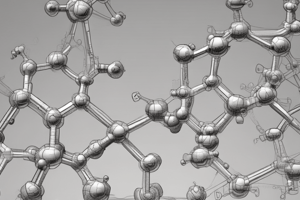Podcast
Questions and Answers
Which statement accurately describes the general relationship between the size of an alkane molecule and its boiling point?
Which statement accurately describes the general relationship between the size of an alkane molecule and its boiling point?
- Larger alkanes generally have higher boiling points due to increased van der Waals forces. (correct)
- Smaller alkanes tend to have higher boiling points due to stronger intermolecular forces.
- Boiling points of alkanes are independent of their molecular size.
- Larger alkanes always exist as gases at room temperature, regardless of boiling point.
A hydrocarbon molecule contains 7 carbon atoms and exhibits a cyclic structure. How many hydrogen atoms are present in the molecule?
A hydrocarbon molecule contains 7 carbon atoms and exhibits a cyclic structure. How many hydrogen atoms are present in the molecule?
- 18
- 14 (correct)
- 16
- 12
Which of the following statements accurately differentiates between structural isomers?
Which of the following statements accurately differentiates between structural isomers?
- Structural isomers have different molecular formulas but the same arrangement of atoms.
- Structural isomers have different molecular formulas and different arrangements of atoms.
- Structural isomers have the same molecular formula and the same arrangement of atoms.
- Structural isomers have the same molecular formula but different arrangements of atoms. (correct)
What type of hybridization is exhibited by carbon atoms in alkanes, and what is the resulting geometry around each carbon?
What type of hybridization is exhibited by carbon atoms in alkanes, and what is the resulting geometry around each carbon?
Which of the following alkanes would likely be found as a gas at room temperature (approximately 20-25°C)?
Which of the following alkanes would likely be found as a gas at room temperature (approximately 20-25°C)?
Consider an alkane with 5 carbon atoms. Which of the following is a correct systematic (IUPAC) name for a branched isomer of this alkane?
Consider an alkane with 5 carbon atoms. Which of the following is a correct systematic (IUPAC) name for a branched isomer of this alkane?
An unknown alkane is found to have a boiling point of 300°C. In which of the following applications is it most likely to be used?
An unknown alkane is found to have a boiling point of 300°C. In which of the following applications is it most likely to be used?
A chemist discovers a new alkane with the molecular formula $C_{11}H_{24}$. Is this an alkane or cycloalkane and why?
A chemist discovers a new alkane with the molecular formula $C_{11}H_{24}$. Is this an alkane or cycloalkane and why?
Which physical property is least likely to be different between two constitutional isomers?
Which physical property is least likely to be different between two constitutional isomers?
If a straight-chain alkane has 8 carbon atoms, how many hydrogen atoms does it have?
If a straight-chain alkane has 8 carbon atoms, how many hydrogen atoms does it have?
Flashcards
Alkanes and Cycloalkanes
Alkanes and Cycloalkanes
Hydrocarbons containing only carbon and hydrogen atoms with single carbon-carbon bonds.
Alkane General Formula
Alkane General Formula
CnH2n+2
Cycloalkane General Formula
Cycloalkane General Formula
CnH2n
Petroleum Fractions
Petroleum Fractions
Signup and view all the flashcards
Tetrahedral Geometry
Tetrahedral Geometry
Signup and view all the flashcards
Branched Alkanes
Branched Alkanes
Signup and view all the flashcards
Constitutional Isomers
Constitutional Isomers
Signup and view all the flashcards
Isobutane
Isobutane
Signup and view all the flashcards
Study Notes
Nomenclature of Alkanes and Cycloalkanes
- Naming conventions and conformations will be discussed, especially for cycloalkanes.
- Model kits are recommended to help visualize molecules, and are available for checkout in some student centers.
Alkanes and Cycloalkanes
- Hydrocarbons that contain only hydrogen and carbon atoms.
- They have all carbon-carbon single bonds; double bonds indicate alkenes, and triple bonds indicate alkynes.
General Formulas
- Alkanes have a general formula of CnH2n+2.
- Hexane with 6 carbons has the formula C6H14.
- Cycloalkanes have a general formula of CnH2n.
- A cyclohexane with six carbons has 12 hydrogens.
Petroleum and Alkanes
- Alkanes are commonly sourced from petroleum and are separated into fractions based on different boiling points.
- Small alkanes (C1-C4) such as methane to butane, are gases and boil below 20 degrees Celsius.
- Alkanes in the C5-C6 range, like pentane and hexane, are liquids that boil between 20 and 60 degrees Celsius.
- Gasoline contains a mixture of alkanes ranging from C5 to C10.
- Larger alkanes (C12 and above) become kerosene and jet fuel, possessing high boiling points.
- Even larger alkanes are found in diesel oil and car oil, with boiling points potentially reaching 200 to 400 degrees Celsius.
- Very large alkanes are called non-volatile liquids, they don't evaporate as easily and have high molecular weights, or exist as solids.
Shape of Alkanes
- Carbon atoms in alkanes are sp3 hybridized.
- sp3 hybridization results in a tetrahedral geometry, leading to a zigzag shape in alkanes.
- Straight chain alkanes, or unbranched alkanes, have no substituents coming off the main chain.
Branched Alkanes
- Branched alkanes have substituents branching off the main carbon chain, so they are no longer straight.
- Isobutane is an example of a branched alkane with a specific common name.
- Isobutane, shaped like a "Y", can also be named 2-methylpropane using IUPAC nomenclature.
- Neopentane, another common name, has five carbons arranged in a tetrahedral shape and can be systematically named 2,2-dimethylpropane
Isomers
- Constitutional isomers, such as butane and isobutane, share the same molecular formula but differ in connectivity so they are arranged differently.
- The number of possible isomers increases with the number of carbon atoms.
- Number of possible isomers can jump from 2 to 35 when chain length goes from 4 to 9 carbons.
- Isomers have distinct physical properties, including melting points, boiling points, densities, and Rf values.
Studying That Suits You
Use AI to generate personalized quizzes and flashcards to suit your learning preferences.



